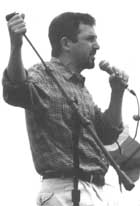 |
At the End of the American
Century:
Two million by 2000

By Adam J. Smith, Associate Director
|
 |
As the days until the coming of the big 00 dwindle
to a hurried few, it seems the proper time to take stock of where
we are, and where we're going. That's why a report, issued last
week by the Justice Policy Institute, should give us pause. Its
central finding is uniquely disturbing for what it says about
America, and American leadership, as we prepare to pass through
this numerical and socially significant milestone of time.
According to JPI, one of the first significant
American events of the post 1900's will take place on February
15, 2000. On that date the prison and jail population in this
country will reach 2,000,000 for the first time in our history.
More than half of those will be nonviolent offenders. The largest
category of offenders, by a wide margin, will be drug law violators.
No other nation on earth, nor any nation in history, as far as
anyone can tell, has ever incarcerated so large a percentage
of its citizens. Not only is the raw number growing, but the
rate of increase is growing as well.
In 1970 there were fewer than 200,000 people
behind bars in the US. By 1980 that number had grown to 315,000.
Between 1980 and 1990 the number rose to 739,980. Ten years later
we have added more than one million to that total. What we have
witnessed, then, in a span of thirty years, is a tenfold increase
in the number of people in a prison system that has, by virtue
of this growth, become an industry unto itself.
As we reach the end of the American Century,
it seems that cages have become our one-size-fits-all answer
to nearly every persistent social ill. Poverty, mental illness,
and substance abuse have each become fodder for the prison-industrial
complex. Hundreds of thousands of people have been removed from
the unemployment statistics, from the rolls of understaffed mental
health services, from overcrowded poor neighborhoods. People
who self-medicate, who don't fit in, who show a preference for
the wrong intoxicants have a home in one of our many correctional
institutions at twenty to thirty thousand dollars per year per
person.
We are a nation of jailers... and of jailed.
We have zero-tolerance, and we brag about it. Our leaders ride
to power on the backs of the convicted. Brown backs, black backs,
for the most part. We have created powerful lobbies of people
whose livelihoods depend on putting more of their fellow citizens
in cages, for longer stretches of their lives, and we cannot
seem to appease those lobbies fast enough.
This is America, home of the free, at the
dawn of the new millennium. We are a nation singular in our urge
to punish, and in our willingness to indulge that urge. But we
are paying for that indulgence.
We are paying with our tax dollars twice,
both what we spend to catch, convict and incarcerate the two
million and what we fail to collect from their potential wages.
We are paying in distrust of our system and of our institutions
among those groups, Black and Latino mostly, against whom we
have chosen to enforce the most punitive of our laws. We are
paying with our futures in the education dollars that have gone,
in state after state, into the building and running of prisons,
and more so every year. We are paying deeply with our souls,
scarred and hardened by a growing willingness to accept that
which we know is immoral and inhumane and corrupt.
So here we are, at the begining of a new millennium,
rushing headlong toward two million, and not so far, at the current
rate, from four million, and six million and twelve million behind
bars. Today, with less than 5% of the world's population, the
United States houses 25% of the world's prisoners. This is the
future we are handing to our children. This is the America they
are growing up to know, accept, and to expect. On February 15,
2000 we will mark the next great milestone in America's all-encompassing
social program. Perhaps this truly is the end of the American
century.

|